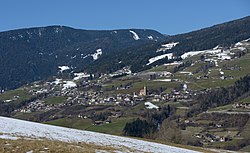Villandro
| Villanders | |
|---|---|
| Comune | |
| Gemeinde Villanders Comune di Villandro |
|

View from NE
|
|
| Location of Villanders in Italy | |
| Coordinates: 46°38′N 11°32′E / 46.633°N 11.533°ECoordinates: 46°38′N 11°32′E / 46.633°N 11.533°E | |
| Country | Italy |
| Region | Trentino-Alto Adige/Südtirol |
| Province / Metropolitan city | South Tyrol (BZ) |
| Frazioni | St. Stefan (Santo Stefano), St. Moritz (San Maurizio), St. Valentin (San Valentino) |
| Government | |
| • Mayor | Walter Baumgartner |
| Area | |
| • Total | 44 km2 (17 sq mi) |
| Elevation | 880 m (2,890 ft) |
| Population (Nov. 2010) | |
| • Total | 1,912 |
| • Density | 43/km2 (110/sq mi) |
| Demonym(s) | German: Villanderser Italian: Villandresi |
| Time zone | CET (UTC+1) |
| • Summer (DST) | CEST (UTC+2) |
| Postal code | 39043 |
| Dialing code | 0472 |
| Website | Official website |
Villanders (German pronunciation: [fɪˈlandɐs]; Italian: Villandro [vilˈlandro]) is a village and comune in South Tyrol in northern Italy with 1875 inhabitants (12/31/2013). It is situated in the Isarco Valley (Italian: Valle Isarco; German: Eisacktal) above Klausen (Italian: Chiusa).
Villanders lies on the Villanderer Berg (Mountain of Villanders), at the top of which lies the Totensee (Lake of death). The village is bordered by Barbian, Klausen, Lajen, Ritten and Sarntal.
The emblem is party per fess of azure and gules, in the first three points of argent, in the second a fess dancetty of argent. It is the arms of the local Lords of Vilanders and Pardell. The emblem was granted in 1966.
Villanders was first mentioned in an official document in 1070 under the name Filandres; in 1085 under the name Filanders, later on as Filanders or Vylanders.
The origin of the name Villanders, which is often believed to derive from the term "viel anders" meaning "a lot different", is not clear to date. Sometimes, the name is believed to have pre-Roman origins (similar to the neighbouring villages Verdings/Verdignes and Feldthurns/Velturno). Other linguists have tried to look for Roman roots (for example "villa antrorum" or "valles antri"), while others even suspect a connection to Flanders in Belgium. However, none of these proposals is convincing. Following a legend, some people in Villanders believe the village was first called "Schönberg", meaning beautiful mountain, and when it was destroyed by a landslide, everything looked "a lot different" ("viel anders" in German) afterwards.
...
Wikipedia

